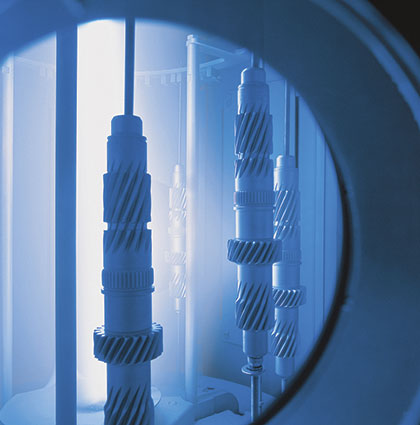Although bearings, gears, rollers, and other precision components are generally made of hardened steel or metal alloys, those utilized in high load applications still can fail due to excessive wear, surface fatigue, pitting, galling, and corrosion. This is exacerbated in applications with metal-to-metal interaction, repetitive friction at high speeds, or where little to no lubrication is present. Other factors include the presence of contaminants, the prevailing service temperatures, the loads applied, and loading modes such as sliding, rolling, oscillating, and pulsating.
To address this problem, product engineers and component manufacturers often turn to specialized PVD (physical vapor deposition) coatings that can be applied in thicknesses of 0.5 to 4 micrometers to further harden the surface of these parts. By applying coatings optimized for these types of punishing environments, components benefit from increased surface hardness and a much lower coefficient of friction. As a result, these critical parts do not have to be replaced as frequently, if at all, reducing maintenance and unplanned downtime while improving machinery performance.
Today, these coated components are utilized for a variety of applications from performance automotive and racing to wind turbine shaft bearings and planetary gears; stainless steel cutting blades and piston pumps for food processing; and sliding components in filling and bottling operations. The coatings are also a proven technique for upgrading critical rotating parts in hydraulic drives, pumps, and valves.
HARDENED COMPONENTS
Many components are not coated at all. Instead, these parts are often made of heat-treated, nitrided or case-hardened steels, along with durable high performance materials such as titanium or nickel based alloys. Even those used in high load, high wear applications are subject to wear and premature failure under poor lubrication. Some industries allow no lubrication at all, such as cryogenic and vacuum systems, clean rooms, food, and pharmaceutical equipment.
When this is the case, engineers often turn to a variety of coating, plating, or nitriding options to modify the surface to improve wear and corrosion resistance. Examples include coating the parts with black oxide. Black oxide is a coating produced by a chemical reaction between the iron on the surface of a ferrous metal and oxidizing salts. After a post-treatment with oil, the surface provides protection against corrosion, improved lubricity, and prevents galling during metal-to-metal interactions.
However, black oxide is not very durable and can be worn away quickly in repetitive, high load applications. PTFE, another popular coating alternative, is known for its low coefficient of friction but is not recommended for high load applications where it, too, can wear away. Hard chrome and chemical nickel plating are often specified, as well, to provide protection against wear and corrosion.
Although hard chrome is suitable for components that experience abrasive wear, microcracking inherent to the process limits its use against corrosion. Although this can be addressed with thin coatings that increase surface hardness, these solutions only offer limited wear resistance. Chemical nickel can be applied over a range of hardnesses. However, the maximum is only 600 HV (Vickers Pyramid Number). Concerns over polluting compounds, emissions, or residues are also associated with these plating techniques.
SPECIALIZED PVD COATINGS
Physical vapor deposition (PVD) describes a variety of vacuum deposition methods that can be used to produce thin coatings. PVD is typically used to coat components at relatively low coating temperatures of 392 to 932 degrees Fahrenheit (200 to 500 degrees Celsius). These temperatures are ideal because they are below the tempering temperature of steels so as to avoid altering the fundamental material properties. Fortunately, there are several carbon-based coatings available that provide a unique combination of extreme surface hardness, low friction coefficient, and anti-corrosion properties like those provided by global coating provider Oerlikon Balzers.
According to Manfred Berger, market segment manager general engineering components for Oerlikon Balzers, the company’s BALINIT C coating is a WC/C ductile carbide carbon coating that is highly resistant to adhesive wear (scuffing) in particular. It has a high load-bearing capacity even under conditions of deficient lubrication or dry contact. Due to its low friction coefficient, it acts to reduce pitting and fretting corrosion
Another example is the BALINIT DLC coating, a metal-free, carbon based coating that is even more durable. Applied through Plasma-Assisted Chemical Vapor Deposition (PACVD), this coating is designed for more severe wear conditions and high relative sliding speeds to protect against abrasion, scuffing and cold welding.
These and other coatings within the BALINIT family that are tailored to specific requirements can be applied to a variety of case-hardened or tempered steels, austenitic stainless steel as well as nickel, titanium, copper, magnesium, and aluminum alloys.
“These materials provide an excellent combination of low coefficient of friction like PTFE, but with the hardness of a ceramic,” explains Berger.
The coatings also have the advantage of being thin, typically 0.5-4 μm. This feature, in conjunction with close tolerancing, means that the component retains its form, fit and dimensions after coating without the need for re-machining.
A LOOK AHEAD
In next month’s conclusion, we’ll take a closer look at how specialized PVD coatings increase surface hardness and durability for potential applications such as bearings, gears, and rollers to significantly increase lifespan under high load conditions.
Oerlikon Balzers is one of the world’s leading suppliers of surface technologies that significantly improve the performance and durability of precision components and tools for the metal and plastics processing industries. For more information, call 408.375.4408, email balzers.components@oerlikon.com, or visit www.oerlikon.com/balzers.
____________________________________________
MODERN PUMPING TODAY, January 2018
Did you enjoy this article?
Subscribe to the FREE Digital Edition of Modern Pumping Today Magazine!
![]()



